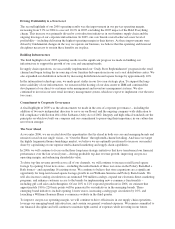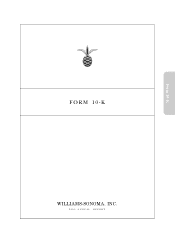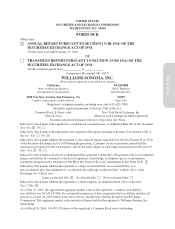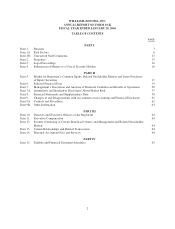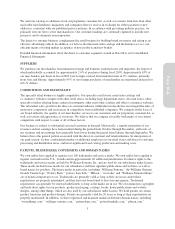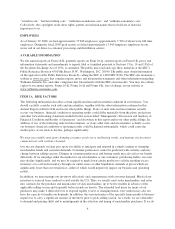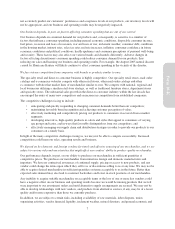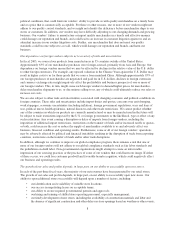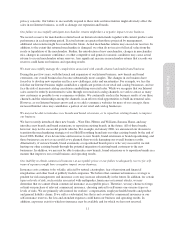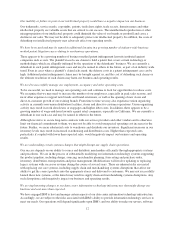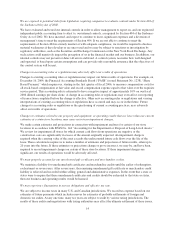Pottery Barn 2005 Annual Report Download - page 16
Download and view the complete annual report
Please find page 16 of the 2005 Pottery Barn annual report below. You can navigate through the pages in the report by either clicking on the pages listed below, or by using the keyword search tool below to find specific information within the annual report.In 2004, the Chambers brand was retired as a result of the launch of Williams-Sonoma Home, our newest brand.
This new premium brand, offering classic home furnishings and decorative accessories, extends the Williams-
Sonoma lifestyle beyond the kitchen into every room of the home. In addition, we launched our first Hold
Everything e-commerce website and opened three new prototype stores.
In 2005, we opened our first Williams-Sonoma Home stores, including a flagship store in Los Angeles,
California. In addition, in January 2006, after testing five new prototype stores and several merchandise
assortment transitions throughout 2004 and 2005, we decided to transition the merchandising strategies of the
Hold Everything brand into our other existing brands by the end of fiscal 2006.
RETAIL STORES
The retail segment has six merchandising concepts (Williams-Sonoma, Pottery Barn, Pottery Barn Kids, Hold
Everything, West Elm, and Williams-Sonoma Home). As of January 29, 2006, we operated 570 retail stores,
located in 43 states, Washington, D.C. and Canada. This represents 254 Williams-Sonoma, 188 Pottery Barn, 89
Pottery Barn Kids, 8 Hold Everything, 12 West Elm, 3 Williams-Sonoma Home, and 16 Outlet stores (our Outlet
stores carry merchandise from all merchandising concepts).
In fiscal 2006, we expect to increase retail leased square footage by approximately 8%, including 28 new stores
(10 in West Elm, 5 in Pottery Barn, 4 in Pottery Barn Kids, 4 in Williams-Sonoma Home, 3 in Pottery Barn Bed
+ Bath and 2 in Williams-Sonoma) and 22 remodeled or expanded stores (13 in Williams-Sonoma, 6 in Pottery
Barn, 2 Outlet stores, and 1 in Pottery Barn Kids), offset by the permanent closure of 8 stores (associated with the
closure of all of our remaining Hold Everything stores) and the temporary closure of 18 stores (12 in Williams-
Sonoma, 4 in Pottery Barn, and 2 Outlet stores). Of the 22 remodeled or expanded stores, four stores
(1 Williams-Sonoma, 2 Pottery Barn and 1 Pottery Barn Kids) are in the New Orleans area and are reopening
after having been temporarily closed in August 2005 due to Hurricane Katrina. The average leased square
footage for new and expanded stores in fiscal 2006 will be approximately 19,300 leased square feet for West
Elm, 14,900 leased square feet for Williams-Sonoma Home, 13,000 leased square feet for Pottery Barn, 7,500
leased square feet for Pottery Barn Kids, 7,400 leased square feet for Pottery Barn Bed + Bath, and 6,800 leased
square feet for Williams-Sonoma.
The retail business complements the direct-to-customer business by building brand awareness. Our retail stores
serve as billboards for our brands, which we believe inspires confidence in our customers to shop via our
direct-to-customer channels.
Detailed financial information about the retail segment is found in Note M to our Consolidated Financial
Statements.
DIRECT-TO-CUSTOMER OPERATIONS
The direct-to-customer segment has seven merchandising concepts (Williams-Sonoma, Pottery Barn, Pottery
Barn Kids, PBteen, Hold Everything, West Elm and Williams-Sonoma Home) and sells products through our
eight direct-mail catalogs (Williams-Sonoma, Pottery Barn, Pottery Barn Kids, Pottery Barn Bed + Bath, PBteen,
Hold Everything, West Elm and Williams-Sonoma Home) and six e-commerce websites (williams-sonoma.com,
potterybarn.com, potterybarnkids.com, pbteen.com, westelm.com, and holdeverything.com). Of these seven
merchandising concepts, the Pottery Barn brand and its extensions have been the major source of revenue growth
in the direct-to-customer segment for the last several years. We believe that the success of the Pottery Barn brand
and its extensions reflect our continuing investment in product design, product quality and multi-channel
marketing.
The direct-to-customer channel over the past several years has been strengthened by the continued success of the
Pottery Barn Kids brand, the introduction of e-commerce websites in all of our core brands and the launching of
our newest brands, West Elm, PBteen and Williams-Sonoma Home. Although the amount of e-commerce
revenues that are incremental to our direct-to-customer channel cannot be identified precisely, we estimate that
approximately 40% of our company-wide non-gift registry Internet revenues are incremental to the
direct-to-customer channel and approximately 60% are driven by customers who recently received a catalog.
4


